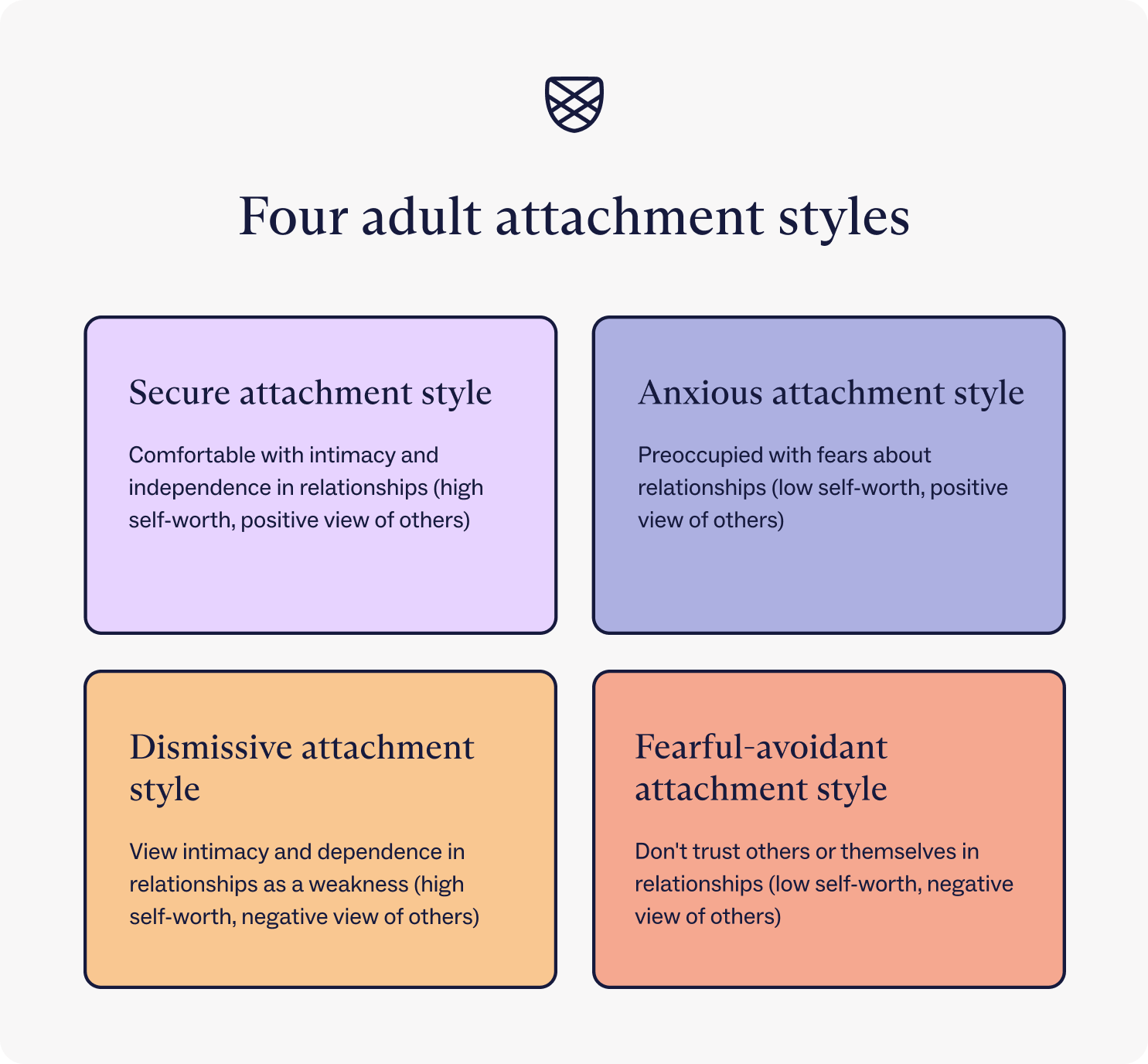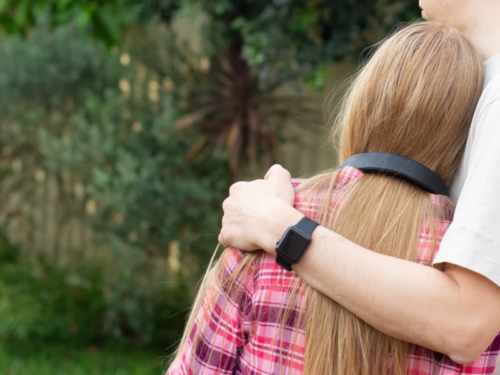
Table of Contents
Do You Have an Avoidant Attachment Style?

Written By: Dr. Rasna Kaur Neelam

Clinically Reviewed By: Dr. Don Gasparini
January 5, 2023
6 min.
The fearful-avoidant attachment style is an attachment style characterized by low self-esteem and a fear of relationships and intimacy. In this article, we will review this attachment style and discuss how an individual can move from this insecure attachment style to a more secure one.
Learn more about our Clinical Review Process
Table of Contents
Emily is a college student who tends to keep to herself. She would like to be more social and spend time with friends, but she doesn’t think that any of her friends actually like her. Emily is also dealing with:
- Depression
- Lack of trust in her relationships
- Self-isolation
- Social avoidance
While it is impossible to accurately diagnose or describe an individual with limited information, the above sample character description captures many of the common traits seen in people with an anxious-preoccupied attachment style, which we explore below.
What are attachment styles?
Attachment styles are the types of behavior individuals showcase in and around relationships with others. Attachment styles can describe all kinds of relationships – friendships, romantic relationships, relationships between parents and their children, and more.
Knowing what your attachment style is can help you better understand why you feel certain emotions regarding relationships. These feelings may include fear and disgust, anxiety and vulnerability, security and confidence, or others.
Keep in mind that it is always possible to move from an unhealthy, or insecure, attachment style to a more secure one through the help of therapy or other types of support. Additionally, it is entirely possible to have more than one attachment style.
The basis of the four attachment styles rests on how individuals view themselves and how individuals view others.
What does this mean?
Ask yourself the following two questions:
- Do you believe you are worthy of love and support?
- Do you think other people are trustworthy, available, and accepting?
Based on your answers to the two questions above, the table below, describing four attachment styles, can shed light on your own attachment style.
The focus of this blog post is the attachment style in the bottom right corner (Cell III), titled “Fearful.” Individuals who fall into this type of attachment style would generally answer “no” to the first question above and “no” to the second.

Fearful-avoidant attachment style
The fearful-avoidant attachment style combines some elements of the two other insecure attachment styles – anxious-preoccupied and dismissive-avoidant. As a reminder, individuals with an anxious-preoccupied attachment style desire relationships but fear rejection and have low self-esteem. Individuals with a dismissive-avoidant attachment style have high self-esteem and feel that relying or leaning on others is a vulnerability or weakness.
People with a fearful-avoidant attachment style have a negative opinion of themselves but also have negative impressions of others. They believe they are unlovable or not worthy of love, and also have the expectation that others will behave in untrustworthy or rejecting ways. This leads to behavior that is fearful of intimacy and these individuals often avoid social interactions.
Do you need more support with
your mental health?
Charlie Health can help.
Fearful-avoidant traits
In a research study introducing the four-category model of attachment styles, researchers studied students in an introductory psychology course and asked them to fill out questionairres. These questionnaires asked questions about demographics, friendships, self-esteem, self-acceptance, sociability, relationships, interpersonal problems.
From information gathered in the study, we know that individuals with an fearful-avoidant attachment style are more likely to do the following:
Have low self-esteem
Individuals with a fearful-avoidant attachment style are less confident and may even suffer from mental health disorders.
Assume a less important role in close relationships
When people with this attachment style do have friendships or relationships, they tend to make themselves “smaller,” and assume a more subordinate role.
Rely on others less
These individuals are less likely to form close relationships, less likely to rely on others or tell others personal information about themselves, be more isolated, and have fewer romantic relationships. When they get close to someone or show a desire to get to know someone more intimately, these individuals may push others away or forcibly keep a distance due to their inability to trust and open up to others.

What might cause someone to be fearful or avoidant in relationships?
Clinicians explain that the way we learn to attach to others is through the type of care we receive early in childhood. As a result, the following parental behaviors may lead to a child with an anxious-preoccupied attachment style.
Inconsistent care
Inconsistent care refers to parents who do not consistently provide care and are not consistently responsive to their child. Avoidant individuals may have had needs that were unmet as a child and had attachment figures that did not meet these needs. Over time, this teaches children to distrust others and rely on themselves.
Of note, inconsistent care may not be “intentional.” It may be related to mental illness, substance, poverty, and other factors of caretakers. For a number of reasons, these children learn that they can only survive if they care for themselves.
Neglect or abuse
Children who experience threatening behavior and abuse may have low self-esteem and worry about the reliability of caretakers or other relationships. This type of treatment in early childhood may cause the individual to withdraw and become fearful of intimacy later in life.
Other factors outside of early parent-child experiences inform our relationships as we enter adolescence and adulthood, explains Pamela Li, Editor-In-Chief of parenting for brain.
As you read the following, consider how these may impact your own attachment style.
- The development of an individual’s social competence: Social competence is a person’s ability to interact successfully with others. This involves reading social cues, responding to those cues, communicating effectively, and resolving conflicts. This is often learned in childhood. Being successful at this skill set often means you are more likely to have friends and enjoy interacting with others. Social competence is also strongly related to mental health, self-esteem, academic performance, staying out of trouble and more. Do you consider yourself socially competent? Why or why not?
- Relationships with peers: Relationships with friends, romantic partners, teachers, coaches, and friends, not just your parents, all influence the type of person we become. The people we interact with also impact our attachment style. Are your relationships successful? Do you have many or few friendships and relationships? All of these experiences contribute to your view of others and to your future relationships.
- Genetic influences: While this is an area of ongoing research, we know that certain genetics may predispose us to certain attachment styles.
It is also possible for an individual with or without any of the above experiences to develop an fearful-avoidant attachment style. Through therapy, these individuals can work to understand the reasoning behind their fears and anxieties and move to a healthier and more secure attachment style.
Moving from an insecure to secure attachment style
Because individuals with an fearful avoidant attachment style often have low self-esteem and a fear of relationships, therapy can be a good way to help these individuals be more confident and learn to trust again.
The first step involves acknowledging you may have a fearful-avoidant attachment style and committing to getting the help that you need.
Some ways in which therapy can help include:
- Understanding why you feel anxious and lack trust in relationships
- Unpacking why you might have low self-esteem
- Learning self-compassion
- Reframing and reworking negative self-talk
- Practicing social competency
- Discussing ways in which you can make small steps to open up to others in a healthy way and recreate your boundaries
- Working on self-care
- Improving communication
At Charlie Health, we’re here to help. Charlie Health specializes in helping clients ages 11-30 work through serious mental health conditions like anxiety, depression, trauma, self-harm, behavioral issues and more. We know that healing starts at the root, and sometimes that means getting to the core of your attachment style. Get started today.





